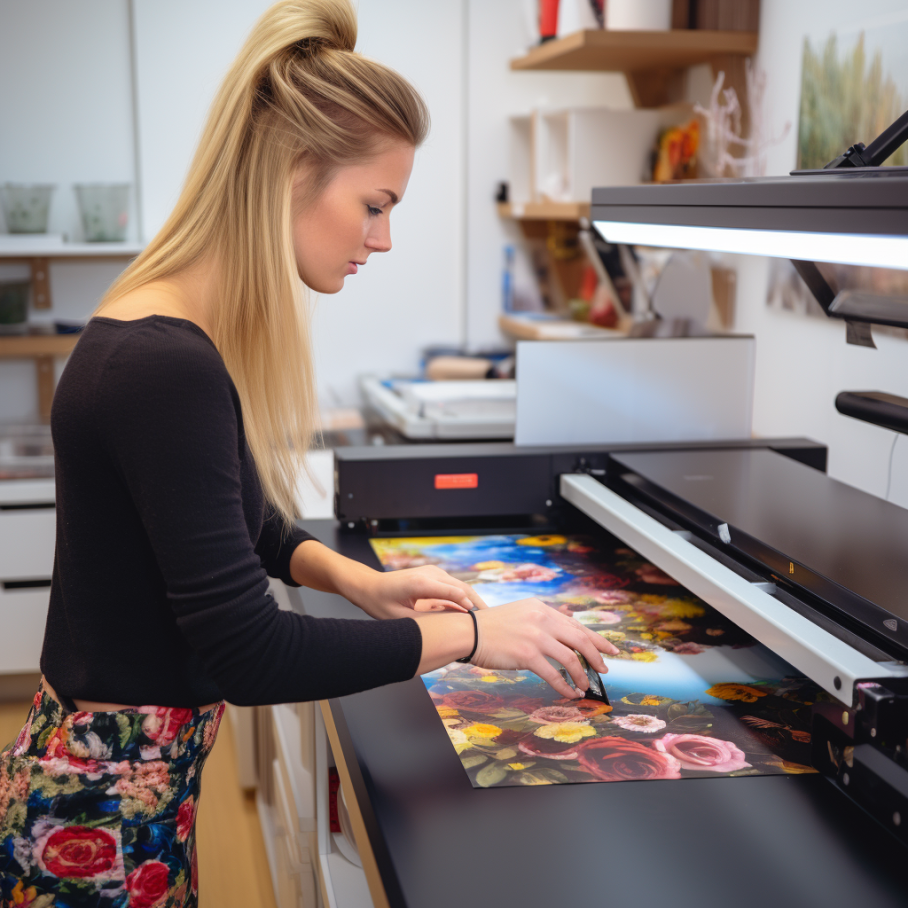Who hasn't been amazed by the arrival of a beautifully packaged product? That moment when you hold a parcel in your hands, anticipation filling every fiber of your being as you slowly unwrap layers of thoughtfulness and care... Ah, the joy of unboxing, right?
But have you ever stopped to think about what goes into creating that packaging?
In this article, we're about to take you behind the scenes of the printing world. We will talk about the often-undiscussed topic of digital vs. offset printing for packaging and explore the differences between these two techniques.
Digital printing offers quick, flexible, and cost-effective packaging solutions for small to medium-sized businesses, excelling in customization and personalization. In contrast, offset printing provides top-notch printing quality and color accuracy, making it ideal for large print runs with stable designs. The choice between digital and offset printing depends on your specific needs, budget, turnaround time, and sustainability considerations.
What is Digital Printing?

Digital printing is like your home printer, but on a much larger and fancier scale. Just like you'd click 'print' on your computer and see your document come to life, digital printing involves sending a digital file directly to the printer and printing it onto your packaging material.
It's quick, efficient and doesn't require much setup. The icing on the cake? It allows for high-quality printing with a lot of flexibility. Want to change the design, color, or text on your packaging? With digital printing, it's as easy as updating the file on your computer!
Digital printing is perfect for small to medium-sized businesses. It allows for low-volume orders without compromising on quality. Plus, with no need for plates or a lot of setups, it's usually more cost-effective for these smaller runs.
What is Offset Printing?

Offset printing is the old-school, traditional approach to the printing world. You might think of it as the vinyl record of printing methods – it's been around for a while, and for good reason.
In the offset printing process, your packaging design is first burned onto metal plates. Each plate corresponds to a different color, following the CMYK model (cyan, magenta, yellow, and key/black). These plates are then inked and pressed onto rubber rollers, which finally transfer the design onto the packaging material.
Offset printing is suitable when it comes to printing large batches. It's cost-effective for larger runs because, although the setup might take some time and cost more, the actual printing process is extremely efficient.
From smooth to textured, thin to thick, offset printing can handle a wide variety of packaging materials. If you're looking to print on a unique surface, offset just might have your back.
Furthermore, if you're after impeccable print quality, offset is your go-to. It produces clean, distinct images and colors that are hard to beat. It can also print finer, more detailed graphics than digital.
Digital vs. Offset Printing for Packaging: Which Should You Choose?
Choosing between digital and offset printing for your packaging can feel a bit like being stuck between a rock and a hard place. Both have their unique benefits and potential drawbacks, and the best choice depends largely on your specific needs.
Check out the below comparison of both methods side by side, as well as some guidance on when you might want to choose one over the other.
Printing Quality and Color Accuracy
When it comes to unmatched printing quality and color accuracy, offset printing often takes the trophy. Thanks to the specialized individual CMYK plates, offset printing offers exceptional color clarity and precision. This is a big plus for brands that rely heavily on maintaining color consistency across their packaging. With its superior image sharpness, color consistency, and accuracy, offset printing is also ideal for intricate and high-end packaging designs.
That's not to say that digital printing doesn't hold its own though. Digital print quality is excellent, and for many applications, the difference between digital and offset may not be noticeable at all. It's especially effective when you need to print varied data on each package or when personalization is a key factor. This could apply to unique barcodes, serial numbers, or even personalized messages.
If your packaging demands the utmost in print quality, color consistency, and detailed graphics for large runs, then offset might be your best bet. For flexible, customizable options for smaller runs with still great quality, digital printing stands ready to deliver.
Customization and Personalization
In today's fast-paced, digital world, customization and personalization are more than just buzzwords; they're powerful tools to connect with your customers on a personal level.
When it comes to personalization and customization, digital printing is a clear powerhouse. Imagine being able to tweak your packaging design for a limited edition product, or add a personalized note for a special customer. With digital printing, these scenarios aren't just possible, they're easy and cost-effective. This is because of its ability to print directly from digital files, which allows for quick changes and low-cost variations.
Offset printing, while consistently delivering dependable quality and color accuracy, doesn't share the same flexibility. Each change or customization would require a new plate, which can add up in terms of time and cost. Therefore, offset is typically better suited for stable designs that don't require frequent changes.
If your brand thrives on customization and creating engaging, personalized experiences for your customers, then digital printing might be your top pick. But for consistent, high-quality packaging for larger runs, offset printing will serve you well.
Cost Considerations
Let's talk numbers now. When selecting a printing method, cost is a critical factor that can swing your decision one way or another.
Digital printing is generally more cost-effective for smaller runs. As there are no initial costs of creating plates, you can start printing your packaging materials directly from the get-go. Think of it as a print-on-demand service, which allows for economical short to medium print runs.
Offset printing, on the other hand, typically requires a higher setup cost as it needs individual plates for each color. This means that for smaller runs, it might not be as economical. But here's the catch: once the setup is done, producing large volumes can be incredibly cost-effective. The per-unit cost goes down the more you print, so for larger runs, offset printing is actually more wallet-friendly.
If you're operating on a smaller scale or dealing with limited editions, then digital printing might be more cost-efficient. However, if you're after high volumes and have a consistent design that doesn't necessitate frequent changes, offset printing could be a more economically sound choice.
Turnaround Time
In the world of business and e-commerce, time is absolutely of the essence. Quick turnaround times can be the difference between capitalizing on a trend or missing the boat.
Digital printing is like the speedy rabbit in this race. Because it eliminates the need for plates and drying time, you can go from a design file to printed packaging in a short amount of time. This makes it ideal for businesses that need to print on-demand or fulfil last-minute orders.
Offset printing, while slower to start due to the setup process, can quickly catch up for long print runs. Once the plates are created and the press is running, it can churn out prints at a rapid pace. However, the initial setup and drying time can make the total turnaround time longer compared to digital printing.
If quick turnaround and the ability to adapt to fast-changing demands are critical for your business, then digital printing, with its quick setup and print-on-demand capabilities, might be the way to go. If you're planning a large print run and can afford a bit of prep time, offset printing can deliver high-quality prints at a speedy rate.
Sustainability and Environmental Impact
Nowadays, sustainability is not just an option but an expectation, so considering the environmental impact of your packaging is important.
Digital printing scores well on the sustainability front primarily due to waste reduction. As digital printing allows for exact quantities to be printed, it avoids overproduction and reduces waste. The elimination of plates also means fewer materials used in the process, which reduces its overall environmental footprint.
Offset printing, while traditionally seen as less eco-friendly due to the use of plates and higher energy consumption, has made significant strides in sustainable practices. Many offset printers now use plates that can be recycled or reused, and some use eco-friendly inks instead of petroleum-based ones. Furthermore, since offset printing is more efficient for large runs, it can lead to less energy use per unit compared to digital when printing in bulk.
In essence, both methods have their sustainable advantages. For shorter runs or variable data, digital printing's lack of plate waste and exact quantity printing can be more eco-friendly. For large runs, the improvements in offset printing and its ability to lower energy use per unit can offer a sustainable solution. As always, we recommend partnering with printing providers that prioritize sustainable practices.
Final Thoughts

Your packaging is a tangible touchpoint for your customers. It should reflect your brand's story and commitment to quality as much as the product it holds within. Understanding the differences between digital and offset printing can provide clarity and help you decide on a method that best aligns with your needs.
Whether you lean towards the quick setup and customization prowess of digital printing or the superior quality and efficiency of offset printing for large runs, the choice ultimately boils down to your specific requirements in terms of quality, cost, turnaround time, and environmental impact.
We encourage you to continue learning and exploring. Engage with different printing providers, request samples, and don't hesitate to ask questions. The perfect packaging solution for your products is out there, and with knowledge and persistence, you're sure to find it.
For more business tips and tricks, click here.







